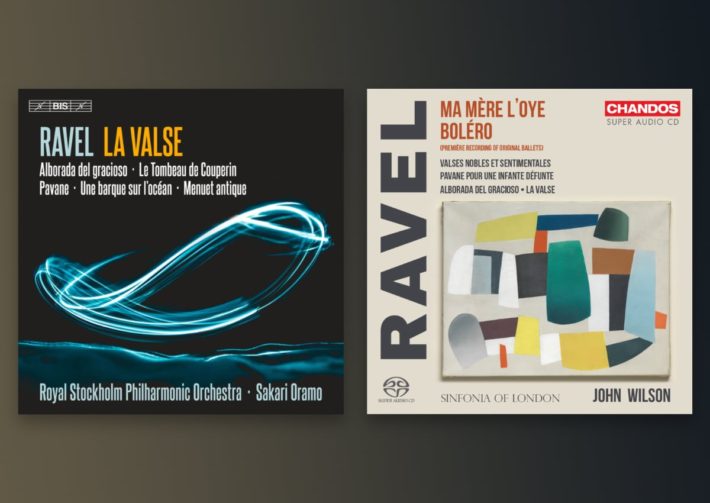Two years ago, I wrote an enthusiastic review of “Escales,” with its performances by John Wilson and the newly reformed Sinfonia of London. It includes a vibrant reading of Ravels’ “Rhapsodie Espagnoles,” so I was keen to hear this same team in more Ravel. This seems to be Sakari Oramo’s first Ravel recording: while his early records from Birmingham are not always successful, his more recent symphony cycles of Elgar and Nielsen (both played by the Royal Stockholm Philharmonic) show that he has grown into an acutely insightful interpreter.
Amazon: Ravel – Orchestral Works – Sinfonia of London & John Wilson
Amazon: Ravel – La Valse & Other Works – Royal Stockholm Philharmonic & Sakari Oramo
The Chandos album begins with a driven “La Valse” of startling clarity. Wilson and the Chandos engineers guarantee Ravel’s dazzling orchestration is fully on display. Nevertheless, the performance has an almost ruthless efficiency about it, as if faultless orchestral technique and splendid sound is the music’s primary purpose. Wilson keeps a tight rein on his players and phrasing is sometimes oddly clipped. The music’s great climax (around 10’00”) has all the necessary weight and tonal splendor, but Wilson rushes through it, thereby robbing the moment of its cataclysmic power. Yes, the playing of the Sinfonia of London is astounding; even the most difficult passages sound easy. But that is surely not the point of this music. Oramo’s orchestra is just as impressive, but they better convey the music’s dark, destructive nature. Their rendering of the climax (10’40”) is more devastating (Oramo stretching out those three angst ridden chords). The orchestra then flings itself into a headlong coda of mechanistic brutality.
If I have a clear preference for Oramo’s “La Valse,” the choice becomes more difficult with the other works common to both albums. Each orchestra plays “Pavane pour une infante défunte” with beguiling beauty, wind solos characterful and deeply touching. The Sinfonia of London strings are particularly sensitive in softer passages, and in both recordings the harp is atmospherically balanced. Playing of similar polish and refinement is heard in “Alborada del gracioso,” though Wilson finds greater buoyancy, more lift in the phrases. But in the final bars Oramo really drives the tempo forward to thrilling effect.
Related Classical Music Posts
- Review: Mussorgsky – Pictures at an Exhibition, Ravel – La Valse – Les Siècles, Roth
- Review: Ravel – Piano Concerto, Le Tombeau de Couperin – Perianes, Pons
- Review: Ammann, Ravel, Bartók – Piano Concertos – Haefliger, Helsinki Philharmonic, Mälkki
Wilson’s album includes two other major works: “Ma mère l’oye” and “Valses nobles et sentimentales.” The Sinfonia of London covers itself in glory throughout, the softer playing again standing out (sample the atmosphere these players conjure in the first two minutes of the Prelude (track 2). The ‘ruthless efficiency’ sensed in “La Valse” is nowhere to be heard – instead, one heard players completely engaged in creating a mood and conveying the emotion of each movement. The final track is a riveting performance of “Bolero,” Ravel’s experiment in crescendo and kaleidoscopic orchestration brilliantly rendered.
Oramo’s recording includes a fascinating surprise. When Ravel first composed his “Le tombeau de Couperin” for piano, the work included six movements, but his later orchestration included only four. Here, the two missing movements (Fugue and Toccata), orchestrated by Kenneth Hesketh, are reinstated. The task of matching Ravel’s skills as an orchestrator must be daunting, but for the most part Hesketh’s work is convincing and it is fascinating to hear how these additional movements alter the balance and weight of the music, especially in these refined and sumptuous readings.
In another, more recent review, I described the Basque National Orchestra’s performance of “Une barque sur l’océan” as vividly evocative, but Oramo’s new performance is even more so, and the Royal Stockholm Philharmonic is a finer orchestra than their Basque colleagues. Their greater tonal sophistication, wedded to Oramo’s surer sense of the music’s architecture, make for a reading of great tonal beauty and alluring atmosphere.
Both albums can be listened to as a multi-channel SACD and regular stereo. The engineering of both recordings is excellent, though the Chandos is a bit more clinical. Both have incredible range and depth, capturing these opulent performances in stunning sound. Choosing between them is a somewhat fruitless exercise – in either case, the listener will discover performances of technical excellence, emotional commitment, and splendid audio.

Ravel – Orchestral Works
Sinfonia of London
John Wilson – Conductor
Chandos CHSA 5280 (83 minutes)
Ravel – La Valse & Other Works
Royal Stockholm Philharmonic Orchestra
Sakari Oramo – Conductor
BIS-2438 (68 minutes)
Recommended Comparisons
Read more classical music reviews or visit The Classic Review Amazon store
Follow Us and Comment:
Get our periodic classical music newsletter with our recent reviews, news and beginners guides.
We respect your privacy.








